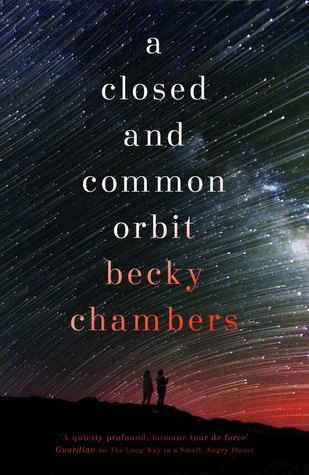 A Closed and Common Orbit by Becky Chambers
A Closed and Common Orbit by Becky Chambers Series: Wayfarers #2
Published by Hodder & Stoughton on October 20th 2016
Genres: Science Fiction
Pages: 365





Great science fiction addresses the concerns of the author’s times and A Closed and Common Orbit by Becky Chambers is no exception. Following on from the acclaimed, and originally self-published, The Long Way to a Small, Angry Planet, this is the story of an AI coming to terms with its identity. The ship in Chambers’ debut was called the Wayfarer and its artificial intelligence was Lovelace. Lovey wakes up in a physical, humanoid body in a world of aliens and varied cultures that she now must negotiate without access to all of the knowledge.
Meanwhile, we’re introduced to Jane 23, a 10-year-old who is working in a scrap recovery factory. It’s a horrendous life. With the rest of the Jane’s she lives a harsh existence controlled by the AI Mothers. Jane 23 becomes the human who is helping Lovey adjust to her new life. The novel is told in two time-streams. Pepper – the name Jane 23 has taken for herself – who is a mechanic and streetwise fixer, and her artist friend Blue are looking after the new physical Lovelace. This alternates chapter by chapter with Jane 23’s early life as she escapes from the factory and finds shelter in an old shuttle, with its AI called Owl. This stream takes Jane up to 10 years before the Pepper thread. I hope that makes sense.
But what of the plot? In Pepper’s thread, not a lot happens for most of the book. Lovey gives itself a name – Sidra. She is in an illegal ‘kit’ with no memory of her former existence. She meets the many alien species that inhabit the world they are on. The encounters are often traumatic for Sidra as she tries to fit in within her constraints. This brings up one of the main themes – the mind/body duality. Am I my body? Chambers explores this full on, in contrast to her universe, where everyone seems to get along. There are a multitude of species, body types, cultures, gender and gender-fluid identities. As with The Long Way to a Small, Angry Planet this book is all about diversity and friendships and getting along with each other because of the differences. It is not until the last third of the book when the story starts to come together and there is a driving force for the characters.
In Jane 23’s thread there is more of a story. It is one of survival and self-discovery. She is raised by Owl, but there are limited supplies, and Owl cannot of course leave the ship. So while Owl teaches Jane all she can, it is out in the wild, hunting for food and materials to repair Owl’s ship that Jane becomes a person. There it is again. Both Lovelace, now Sidra and Jane 23, now Pepper, become who they are in the end. This is plot.
Which is also the only downside of the book. Truly great fiction has an antagonist or conflict for the protagonist to deal with. Of course, Jane has to fight for survival, but in Pepper and Sidra’s time stream, the only obstacles are internal battles and occasional bad parties. Everyone gets along most of the time. Tak is a tattooist who helps on Sidra’s journey of discovery and despite having plenty of opportunities to provide genuine conflict, the gender changing alien always ‘goes along’ with the plans. Chambers writes Tak lacking genuine agency.
However, this is a minor point. There is so much warmth and joy to be found in Chambers’ writing that you get swept along with the characters. When the time streams come together in the final third, A Closed and Common Orbit makes a whole lot of satisfying sense. Identity and diversity are common concerns today and Chambers deals with them in such as lovely manner. Despite a complex universe with a variety of races (Aandrisks, Quelin, Aeluons, or Harmagian) the reader never feels alienated, to use a pun. The inclusiveness is palpable. Credit to Chambers ability to write characters and situations that draw you in, and tie everything up nicely. When Sidra is learning about herself, calling her body ‘the kit’ and when Jane is learning about universe, it never feels forced, as if Chambers is world-building or preaching psychology. All the characters in the book, be they human, alien or artificial, feel properly human.
- Review: Agents of Dreamland by Caitlín R. Kiernan - June 8, 2017
- Review: The End of the Day by Claire North - May 31, 2017
- Review: Norse Mythology by Neil Gaiman - March 8, 2017


No Comments
Comments are closed.